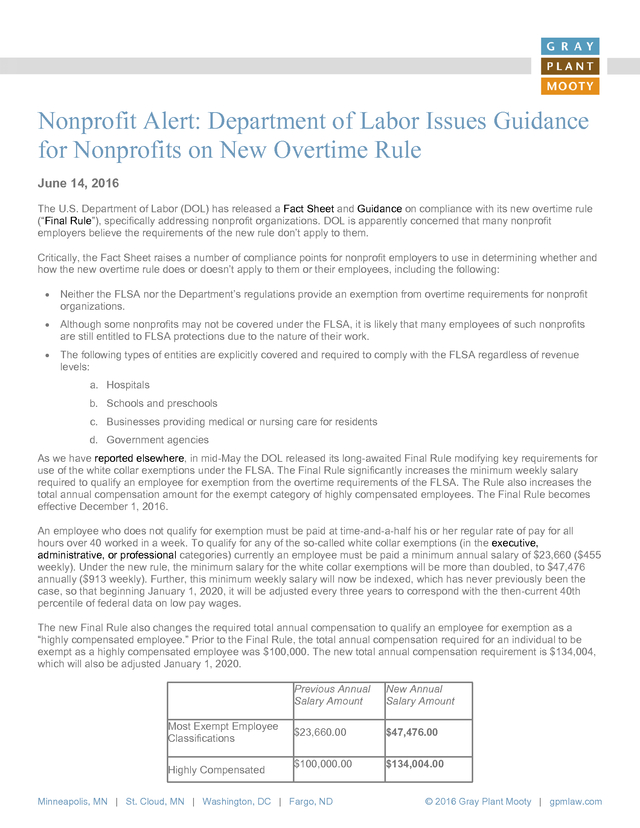Nonprofit Alert: Department of Labor Issues Guidance for Nonprofits on New Overtime Rule – June 14, 2016
Gray Plant Mooty
Description
Nonprofit Alert: Department of Labor Issues Guidance
for Nonprofits on New Overtime Rule
June 14, 2016
The U.S. Department of Labor (DOL) has released a Fact Sheet and Guidance on compliance with its new overtime rule
(“Final Rule”), specifically addressing nonprofit organizations. DOL is apparently concerned that many nonprofit
employers believe the requirements of the new rule don’t apply to them.
Critically, the Fact Sheet raises a number of compliance points for nonprofit employers to use in determining whether and
how the new overtime rule does or doesn’t apply to them or their employees, including the following:
ï‚·
Neither the FLSA nor the Department’s regulations provide an exemption from overtime requirements for nonprofit
organizations.
ï‚·
Although some nonprofits may not be covered under the FLSA, it is likely that many employees of such nonprofits
are still entitled to FLSA protections due to the nature of their work.
ï‚·
The following types of entities are explicitly covered and required to comply with the FLSA regardless of revenue
levels:
a. Hospitals
b.
Schools and preschools c. Businesses providing medical or nursing care for residents d. Government agencies As we have reported elsewhere, in mid-May the DOL released its long-awaited Final Rule modifying key requirements for use of the white collar exemptions under the FLSA.
The Final Rule significantly increases the minimum weekly salary required to qualify an employee for exemption from the overtime requirements of the FLSA. The Rule also increases the total annual compensation amount for the exempt category of highly compensated employees. The Final Rule becomes effective December 1, 2016. An employee who does not qualify for exemption must be paid at time-and-a-half his or her regular rate of pay for all hours over 40 worked in a week.
To qualify for any of the so-called white collar exemptions (in the executive, administrative, or professional categories) currently an employee must be paid a minimum annual salary of $23,660 ($455 weekly). Under the new rule, the minimum salary for the white collar exemptions will be more than doubled, to $47,476 annually ($913 weekly). Further, this minimum weekly salary will now be indexed, which has never previously been the case, so that beginning January 1, 2020, it will be adjusted every three years to correspond with the then-current 40th percentile of federal data on low pay wages. The new Final Rule also changes the required total annual compensation to qualify an employee for exemption as a “highly compensated employee.” Prior to the Final Rule, the total annual compensation required for an individual to be exempt as a highly compensated employee was $100,000.
The new total annual compensation requirement is $134,004, which will also be adjusted January 1, 2020. Previous Annual Salary Amount Most Exempt Employee Classifications Highly Compensated New Annual Salary Amount $23,660.00 $47,476.00 $100,000.00 $134,004.00 Minneapolis, MN | St. Cloud, MN | Washington, DC | Fargo, ND © 2016 Gray Plant Mooty | gpmlaw.com . Employee Classification The Fact Sheet and Guidance both provide good discussion of compliance options for nonprofit employers. Any member of GPM’s Labor, Employment and Higher Education Practice Group would be happy, however, to assist with any further compliance questions you may have. Minneapolis, MN | St. Cloud, MN | Washington, DC | Fargo, ND © 2016 Gray Plant Mooty | gpmlaw.com .
Schools and preschools c. Businesses providing medical or nursing care for residents d. Government agencies As we have reported elsewhere, in mid-May the DOL released its long-awaited Final Rule modifying key requirements for use of the white collar exemptions under the FLSA.
The Final Rule significantly increases the minimum weekly salary required to qualify an employee for exemption from the overtime requirements of the FLSA. The Rule also increases the total annual compensation amount for the exempt category of highly compensated employees. The Final Rule becomes effective December 1, 2016. An employee who does not qualify for exemption must be paid at time-and-a-half his or her regular rate of pay for all hours over 40 worked in a week.
To qualify for any of the so-called white collar exemptions (in the executive, administrative, or professional categories) currently an employee must be paid a minimum annual salary of $23,660 ($455 weekly). Under the new rule, the minimum salary for the white collar exemptions will be more than doubled, to $47,476 annually ($913 weekly). Further, this minimum weekly salary will now be indexed, which has never previously been the case, so that beginning January 1, 2020, it will be adjusted every three years to correspond with the then-current 40th percentile of federal data on low pay wages. The new Final Rule also changes the required total annual compensation to qualify an employee for exemption as a “highly compensated employee.” Prior to the Final Rule, the total annual compensation required for an individual to be exempt as a highly compensated employee was $100,000.
The new total annual compensation requirement is $134,004, which will also be adjusted January 1, 2020. Previous Annual Salary Amount Most Exempt Employee Classifications Highly Compensated New Annual Salary Amount $23,660.00 $47,476.00 $100,000.00 $134,004.00 Minneapolis, MN | St. Cloud, MN | Washington, DC | Fargo, ND © 2016 Gray Plant Mooty | gpmlaw.com . Employee Classification The Fact Sheet and Guidance both provide good discussion of compliance options for nonprofit employers. Any member of GPM’s Labor, Employment and Higher Education Practice Group would be happy, however, to assist with any further compliance questions you may have. Minneapolis, MN | St. Cloud, MN | Washington, DC | Fargo, ND © 2016 Gray Plant Mooty | gpmlaw.com .













